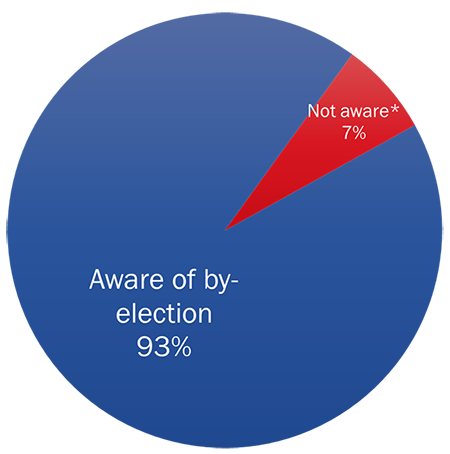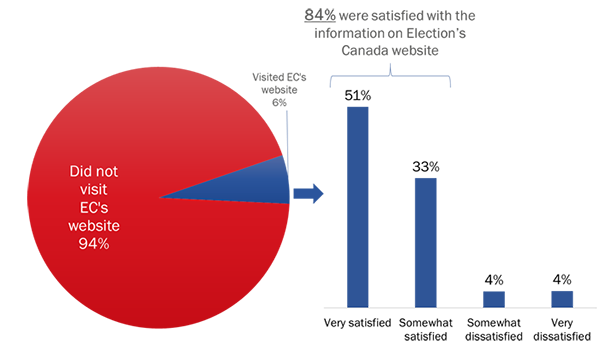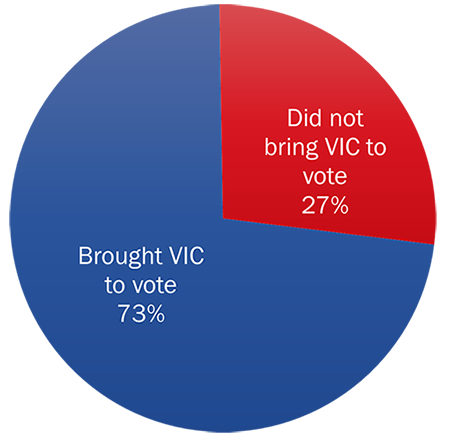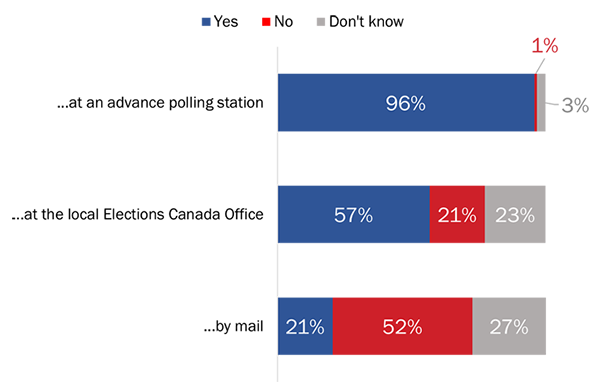POR Number: 011-18
Contract Number: 05005-180183-001-CY
Contract Award Date: 2018-06-12
Date of Submission: 2018-09-10
Contract Value: $31,659.89 (including HST)
September 2018
Prepared for:
Elections Canada
Submitted by:
Phoenix Strategic Perspectives Inc.

Ce rapport est aussi disponible en français.
Elections Canada commissioned Phoenix Strategic Perspectives (Phoenix SPI) to conduct research to help evaluate the June 18, 2018, federal by–election.
Elections Canada (EC) is an independent, non–partisan agency that reports directly to Parliament. The agency is mandated to conduct federal general elections, by–elections and referendums, administer the political financing provisions of the Canada Elections Act (CEA) and monitor compliance with electoral legislation.
As part of its evaluation program, the agency wanted to conduct a survey of eligible electors in the electoral district of Chicoutimi–Le Fjord (Quebec), where a federal by–election was held on June 18, 2018. The purpose of the survey was to evaluate electors' opinions, experience, attitudes and knowledge of the agency's services and various aspects of the electoral process.
More specifically, surveyed electors were consulted on the following issues:
The results will be used to assist in evaluating and refining EC's programs and services to the electorate and in developing the Chief Electoral Officer's reports to Parliament.
An 11–minute random digit dial telephone survey was conducted with 400 eligible electors. Eligible electors were Canadian citizens, at least 18 years of age on polling day (June 18, 2018), and residents of the electoral district (i.e., had an address of ordinary residence in the electoral district) from the first day of the federal by–election period until election day.
An overlapping dual–frame (landline and cell phone) sample was used to minimize coverage error, with 81% of dialling done on cell phone numbers. Those who declined to participate in the survey when contacted by telephone were offered the possibility of completing the survey through an online self–administered questionnaire instead of a phone interview. No one elected to participate using the online questionnaire.
The survey data was weighted to accurately reflect the age and gender distribution of eligible electors. The data collection was conducted June 22 to July 10, 2018. Based on a sample of this size, the results can be considered accurate to within ±4.9%, 19 times out of 20. For a more complete description of the methodology, please refer to Annex 1.
The contract value was $31,659.89 (including HST).
I hereby certify as a Senior Officer of Phoenix SPI that the deliverables fully comply with the Government of Canada political neutrality requirements outlined in the Communications Policy of the Government of Canada and Procedures for Planning and Contracting Public Opinion Research. Specifically, the deliverables do not contain any reference to electoral voting intentions, political party preferences, standings with the electorate, or ratings of the performance of a political party or its leader.
Alethea Woods
President
Phoenix Strategic Perspectives Inc.
The vast majority of respondents (93%) said they were aware that a federal by–election took place on June 18, 2018, in their riding of Chicoutimi–Le Fjord, Quebec.

Long Description of Figure 1: Awareness of By–election
Q1: Did you know that a federal by–election took place on June 18, 2018, in your riding? Base: n=400; all respondents
*Includes those respondents—1%––who said "don't know".
Awareness of the federal by–election was higher among:
Six in ten (61%) of those who were aware of the federal by–election recalled seeing, hearing or reading advertisements or communications from EC about where and when to vote for the June 18, 2018, federal by–election.

Long Description of Figure 2: Recall of Elections Canada Advertisements
Q29. During the election period, did you see, hear or read any advertising or communications from Elections Canada about how, when and where to vote in the by–election on June 18? Base: n=373; those aware of the by–election.
*Percentages may not add to 100% due to rounding.
Recall of advertising or communications was higher among the following:
Those who recalled seeing, hearing or reading advertising or communications from EC for the June 18, 2018, federal by–election were most likely to have mentioned the EC householder (31%), radio (26%) and newspapers (21%) as the source. Following this, 17% of respondents noticed communications from EC from their voter information card.

Long Description of Figure 3: Source of Recall of Elections Canada Advertising
Q29a: Where did you see, hear or read about it? Base: n=224; respondents who recalled communications from EC [Dk/nr: 1%]. (Multiple responses accepted). Note: 28% of respondents mentioned television ads, but EC did not run any television ads in this by–election.
Notable subgroup differences include the following:
While 28% of respondents recalled seeing EC ads on television, there were no such ads during this specific federal by–election. This could be due to several factors, including confusion with other electoral communications, such as partisan advertising or news reports about the federal by–election.
Nearly nine in 10 (87%) respondents aware of the federal by–election felt informed about how, when and where to vote for the June 18, 2018, federal by–election, with 73% saying they felt very informed.

Long Description of Figure 4: Knowledge of How, When and Where to Vote
Q28. Overall, how well informed do you feel you were about how, when and where to vote? Base: n=373; those aware of the by–election [Dk/nr: 1%]
*Percentages may not add to 100% due to rounding.
Respondents in the following subgroups were more likely to feel informed:
Six percent of electors who were aware of the federal by–election visited EC's website during the campaign. Respondents who voted in the federal by–election were more likely to visit EC's website (10%), compared to those who did not (2%).
Of the 23 respondents who visited EC's website, 84% were satisfied with the information provided on the website, with half saying they were very satisfied. Two respondents (8%) were not satisfied with the information on the website.

Long Description of Figure 5: Elections Canada Website
Q30 [left]. Did you visit Elections Canada's website during the campaign? Base: n=373; those aware of the by–election [Dk/nr: <0.5%]
Q31 [right]. Overall, how satisfied were you with the information on Elections Canada's website? Would you say...? Base: n=23; all who visited the site [Dk/nr: 8%]
Two percent of electors who were aware of the federal by–election said they contacted EC during the campaign. Furthermore, all electors who contacted EC were satisfied with the information they received, with 88% saying they were very satisfied.
Most electors (83%) who were aware of the federal by–election said they received their voter information card.

Long Description of Figure 6: Receipt of Voter Information Card
Q4. During the campaign, did you receive a voter information card addressed to you personally and telling you where and when to vote? Base: n=373; those who said they were aware of the by–election
The likelihood of saying they received a VIC was higher among:
More than nine in 10 electors who received a VIC reported it had the correct name (94%) and address (96%). Electors who are retired were more likely to report that the name (98%) and address (99%) on their VIC were correct, compared to respondents who were employed, among whom 90% had a correct name, and 95% had a correct address.
Nearly three–quarters (73%) of electors who voted at an EC office, advance poll, or polling station on election day said they brought their VIC with them.

Long Description of Figure 7: Voter Information Card – Brought to Vote
Q21. Did you bring your voter information card with you to the polling station/advance polling station/local Elections Canada office? Base: n=186; respondents who voted
The likelihood of bringing their VIC to vote was higher among:
Most (86%) electors who did not receive a VIC during the campaign did nothing to find out whether they were registered to vote in the federal by–election. Those who did something to find out if they were registered did so at the polling station or the local EC office (3%), consulted the EC website (3%), or called the 1–800 EC phone number (2%). The remaining 10% relied on other methods to find out if they were registered to vote.

Long Description of Figure 8: Steps Taken to Find out if Registered to Vote
Q7: What did you do to find out whether you were registered to vote in this by–election? Base: n=65; respondents who did not receive a VIC.
*Percentages may not add to 100% due to rounding.
Ninety–two percent of electors knew that they need to be registered in order to vote in a Canadian federal election.

Long Description of Figure 9: Awareness of Registration to Vote
Q8. To the best of your knowledge, do electors need to be registered on the list of electors to vote in a Canadian federal election? Base: n=400; all respondents
The likelihood of knowing that electors need to be registered on the list of electors to vote in a Canadian federal election was higher among:
Among electors aged 18 to 24, a third gave incorrect answers: 11% thought electors did not need to be registered in order to vote, while 22% said they did not know.
Nearly half (48%) of electors surveyed were aware that electors can register at the polling place and then vote immediately after.

Long Description of Figure 10: Election Day Registration
Q9AB. Electors must be registered to vote in a federal election. If an elector is not registered on election day and wants to vote, can they register at the polling place and then vote immediately after? Base: n=400; All respondents.
Notable subgroup differences include the following:
Of note is the absence of any difference according to education, occupation, household size and other common predictors of knowledge about electoral issues.
A split sample was used to test awareness of online registration for the third time.footnote 1 Half the respondents (n=200) were asked if electors could use an "Online Voter Registration Service on EC's website", a question previously used in post–electoral phone surveys. As this question has always yielded a high proportion of "don't know" answers, a simplified formulation was developed and asked to the other half of the sample (see full questions under the graph, below).
In both samples, most electors were aware of online registration (63% and 83%, respectively). However, the second formulation led to a higher proportion of respondents who said "yes", and a lower proportion of respondents who said they "do not know."

Long Description of Figure 11: Awareness of Online Voter Registration
Q10A. To the best of your knowledge, could electors use an Online Voter Registration Service on Elections Canada's website to check, update or complete their voter registration during the last by–election?
Q10B. To the best of your knowledge, is it possible for Canadian electors to check, update or complete their voter registration on Elections Canada's website?
*Base: n=200 for each question; split sample.
**Percentages may not add to 100% due to rounding.
The results of this third split sample test confirm that the second formulation of the question is easier to understand, as it resulted in a smaller proportion of respondents who indicated they did not know.
Regardless of question formulation, respondents aged 55 and older were more likely to say they did not know the answer to this question (33% for combined questions, 43% for the standard question and 21% for the simplified wording) compared to respondents aged 25 to 34 (14% did not know, combined questions) and aged 35 to 54 (13% did not know, combined questions).
Exactly half of electors who were aware of the federal by–election said they voted in the June 18, 2018, federal by–election.

Long Description of Figure 12: Voter Participation in June 18, 2018, By–election
Q2: Which of the following statements describes you? Base: n=373; those who said they were aware of the by–election.
*Percentages may not add to 100% due to rounding.
Significant subgroup differences include:
Of the 183 respondents who said they did not vote during the June 18, 2018, federal by–election, 45% said they did not vote due to everyday life and health reasons. Following closely, 39% reported they did not vote due to political reasons. Very few (5%) did not vote due to electoral process–related reasons.

Long Description of Figure 13: Main Reasons for Not Voting – Themes
Q3: What is the main reason you did not vote? Base: n=183; respondents who did not vote [Dk/nr: 2%]
The likelihood of not voting due to everyday life or health reasons was higher among:
The likelihood of not voting due to political reasons was higher among:
Of note, younger non–voters were more likely to say they were too busy to vote compared to those aged 55 and older: 44% of respondents aged 18 to 24 said they were too busy, a proportion that decreased for those aged 25 to 34 (35%), 35 to 54 (29%) and 55 and older (14%). Further, men were twice as likely to say they were out of town (22%) than women (10%).
The table below provides a breakdown of all the reasons why respondents did not vote during the June 18, 2018, federal by–election.
| Reasons for Not Voting | % |
|---|---|
| Everyday life or health reasons | 45% |
| Too busy | 26% |
| Out of town | 16% |
| Illness or disability | 3% |
| Political reasons | 39% |
| Not interested in politics | 18% |
| Did not like candidates/parties/campaign | 10% |
| Lack of information about campaign issues and parties' positions | 6% |
| Felt voting would not make a difference | 4% |
| Did not know who to vote for | 2% |
| Electoral process–related reasons | 5% |
| Transportation problem/polling station too far | 2% |
| Issues with the voter information card | 1% |
| Not on voters list | Less than 1% |
| Could not prove identity or address | Less than 1% |
| Lack of information about voting process (e.g. when/where to vote) | Less than 0.5% |
| Other reasons | 9% |
| Forgot to vote | 2% |
| Other | 7% |
Of the respondents who said they were out of town (n=30) during the election, 52% said they were out of town due to personal reasons and 48% due to work. Men were more likely to be away due to work (64%), while women were more likely to be away due to personal reasons (87%).
Additionally, 71% of those who were out of town during the election had previously planned their travel. For 29% of these electors, this travel was unplanned.
Nearly all respondents (96%) said they were aware that electors could vote at advance polling stations. Fifty–seven percent said that it is possible to vote at the local EC office, while fewer electors (21%) said electors can vote by mail.

Long Description of Figure 15: Knowledge of Voting Methods
Q11A. At federal elections, is it possible for Canadian electors to vote ... at the advance polling station? Base: n=400.
Q11B. At federal elections, is it possible for Canadian electors to vote ... at the local Elections Canada office? Base: n=400.
Q11C. At federal elections, is it possible for Canadian electors to vote ... by mail? Base: n=400.
*Percentages may not add to 100% due to rounding.
Awareness of the possibility of voting at an advance polling station was higher among:
Awareness of the possibility of voting at a local EC office was higher among:
Women were more aware of the possibility of voting advance polls (99%, compared to 93% for men) and at the local EC office (63%, compared to 50% for men). However, more men (26%) than women (15%) were aware that they can vote through mail.
Three–quarters (74%) of electors reported they voted at a polling station on election day, while 24% went to an advance polling station to vote. A very small proportion of voters reported voting by mail (1%) or at a local EC office (1%).

Long Description of Figure 16: Methods Used to Vote
Q12: Which method did you use to vote? Was it... Base: n=189; all respondents who voted
Electors who voted on election day were more likely to be:
Electors who voted at an advance polling station were more likely to:
Using a split sample, awareness of identification requirements was tested. Traditionally, post–electoral surveys ask respondents whether or not they need a proof of identity to vote, and then the question is repeated for proof of address. In previous post–electoral surveys, this formulation led to very high proportions of "yes" for both questions; however, survey pre–tests seemed to indicate that some respondents did not perceive a difference between the two (i.e., between proof of address and proof of identity). Thus, a second version of this question was developed, asking respondents whether, to the best of their knowledge, electors need proof of identity, proof of address, both, or none. The two formulations were compared using the aforementioned split sample experiment.
Comparable to previous surveys, the first formulation found that virtually all (99%) respondents think that electors have to present proof of identity in order to vote in a Canadian election. Most respondents (85%) also said electors have to present a proof of address. Another 5% said they did not know if proof of address is required.
Of those asked the second formulation, 62% correctly responded that both proof of identity and address are required to vote in a Canadian federal election. In contrast, more than one–third answered incorrectly: 34% of respondents said only proof of identity is needed, 3% said only proof of address is needed, and 1% said neither is needed to vote.

Long Description of Figure 17: Awareness of Voter Identification Requirements
Q14B [left]. Do voters have to present a proof of IDENTITY in order to vote in a Canadian federal election? SPLIT SAMPLE: n=100.
Q15 [left]. Do voters have to present a proof of ADDRESS in order to vote in a Canadian federal election? SPLIT SAMPLE: n=193.
Q14A [right]. In order to vote in a Canadian federal election, must electors provide...? SPLIT SAMPLE: n=207.
The results of this split sample test confirm those of the October 23, 2017, and December 11, 2017, federal by–election survey results. Furthermore, these results suggest that the new formulation leads to results that better reflect respondents' grasp of identification requirements.
Ninety–nine percent of voters found it easy to meet the identification requirements, with 86% saying it was very easy.

Long Description of Figure 18: Ease of Meeting Voter Identification Requirements
Q16. Overall, how easy was it to meet the identification requirements? Would you say that it was...? Base: n=186; respondents who voted at an advance poll or at a polling station on election day [DK/NR: <0.5%]
*Percentages may not add to 100% due to rounding.
Of the respondents who voted during the June 18, 2018, federal by–election, 99% claimed it was easy to vote, with 87% saying it was very easy.

Long Description of Figure 19: Ease of Voting
Q13. Overall, how easy was it to vote? Would you say it was...? Base: n=189; respondents who voted and identified a voting method.
*Percentages may not add to 100% due to rounding.
Ninety–five percent said the building where they voted was suitable, with 82% saying it was very suitable. Furthermore, 98% said that there were enough signs inside the facility to help them find voting stations.
![Figure 20: Voting Facilities [Suitability]](images/image021_e.png)
Long Description of Figure 20: Voting Facilities [Suitability]
Q19. Would you say that the building where you voted was...? Base: n=186; respondents who voted [Dk/nr: <1%]
Virtually all (99%) who voted in person reported that the location of the polling station was a convenient distance from home. Additionally, all those who voted said that it was not difficult to reach the voting location.
The largest proportion (44%) of all voters surveyed, n=186, reported voting between 4 p.m. and 8:30 p.m.
Of the voters who voted on election day (n=140), 23% reported going to vote in the morning (from the opening of polls at 8:30 a.m. till noon), 23% said they voted in the afternoon (between noon and 4 p.m.), and 49% claimed to have voted in the evening (from 4 p.m. till closing of polls).
![Figure 21: Time of Day Voted [Election Day]](images/image022_e.png)
Long Description of Figure 21: Time of Day Voted [Election Day]
Q22. Do you remember approximately what time it was when you went to vote? Base: n=140; respondents who voted on election day. [Dk/nr: 7%]
*Election day polls hours: 8:30 a.m. to 8:30 p.m.
**Percentages may not add to 100% due to rounding.
Six in ten of those who voted at an advance polling stationfootnote 2 (n=44) from June 8 to 11, 2018, reported going to vote in the afternoon (between noon and 4 p.m.).
![Figure 22: Time of Day Voted [Advance Polling]](images/image023_e.png)
Long Description of Figure 22: Time of Day Voted [Advance Polling]
Q22. Do you remember approximately what time it was when you went to vote? Base: n=44; respondents who voted at an advance polling station. [Dk/nr: 14%]
*Advance polling stations were open from 12 p.m. to 8 p.m. on June 8 to 11, 2018.
**Percentages may not add to 100% due to rounding.
Nearly three–quarters (73%) of all voters surveyed said voting took them five minutes or less.
![Figure 23: Length of Time to Vote [all]](images/image024_e.png)
Long Description of Figure 23: Length of Time to Vote [all]
Q23. To the best of your knowledge, how long did it take you to vote at the polling station/advance polling station/local Elections Canada office? This does not include travel time. Base: n=186; respondents who voted
Among those who voted at an advance polling station or on election day, three–quarters said it took them less than five minutes to vote (75% and 74%, respectively). Virtually all (99%) voters found the time taken to vote to be reasonable.
![Figure 24: Length of Time to Vote [Election Day vs. Advance Polling Station]](images/image025_e.png)
Long Description of Figure 24: Length of Time to Vote [Election Day vs. Advance Polling Station]
Q23. How long did it take you to vote at the polling station? This does not include travel time. Base: n=44; respondents who voted at an advance polling station.
Q23. How long did it take you to vote at the polling station? This does not include travel time. Base: n=140; respondents who voted on election day.
*Percentages may not add to 100% due to rounding.
All voters were satisfied with the EC staff, with 88% saying they were very satisfied.

Long Description of Figure 25: Satisfaction with Elections Canada Staff
Q27. Overall, how satisfied were you with the services provided by Elections Canada staff when you voted? Would you say...? Base: n=186; respondents who voted. [Dk/nr: 0.5%]
Similarly, all voters were satisfied with the service they received in their chosen official language.
Ninety–nine percent of voters were satisfied with their overall voting experience during the June 18, 2018, federal by–election, with 81% saying they were very satisfied.

Long Description of Figure 26: Satisfaction with Overall Voting Experience
Q34. Overall, how satisfied were you with your voting experience? Would you say...? Base: n=189; all respondents who voted. [Dk/nr: 1%]
*Percentages may not add to 100% due to rounding.
Most perceive EC ran the federal by–election fairly
Four in five electors (82%) who were aware of the June 18, 2018, federal by–election said that EC ran the election fairly, with 49% saying the federal by–election ran very fairly.

Long Description of Figure 27: Perceptions of Elections Canada's Fairness
Q35. Thinking about the June 18, 2018, federal by–election, would you say that Elections Canada ran the election...? Base: n=373; those aware of the by–election.
*Percentages may not add to 100% due to rounding.
The likelihood of saying the election was run fairly was higher among:
The likelihood of saying the election was run very fairly was higher among:
Non–voters were more likely (25%) than voters (4%) to say they did not know whether EC ran the election fairly or not.
Nine in 10 (90%) respondents who were aware of the federal by–election stated they have a high level of trust in the accuracy of results in their riding.

Long Description of Figure 28: Trust in Accuracy of Results
Q36. What level of trust do you have in the accuracy of the election results in your riding? Is it...? Base: n=373; those aware of the by–election.
Notable subgroup differences include the following:
| Age | Weighted | Unweighted | ||
|---|---|---|---|---|
| n | % | n | % | |
| 18–34 | 95 | 24 | 93 | 23 |
| 35–54 | 112 | 28 | 113 | 28 |
| 55+ | 191 | 48 | 191 | 48 |
| Refusal | 2 | 1 | 2 | 1 |
| Total | 400 | 100 | 400 | 100 |
| Gender | Weighted | Unweighted | ||
|---|---|---|---|---|
| n | % | n | % | |
| Male | 196 | 49 | 220 | 55 |
| Female | 204 | 51 | 180 | 45 |
| Total | 400 | 100 | 400 | 100 |
| Employment Status | Weighted | Unweighted | ||
|---|---|---|---|---|
| n | % | n | % | |
| Employed | 204 | 51 | 205 | 51 |
| Self–employed | 32 | 8 | 32 | 8 |
| Unemployed/Currently looking for work | 6 | 2 | 7 | 2 |
| A homemaker | 16 | 4 | 15 | 4 |
| A student | 23 | 6 | 23 | 6 |
| Retired | 114 | 29 | 113 | 29 |
| Other | 5 | 1 | 5 | 1 |
| Total | 400 | 100 | 400 | 100 |
| Education | Weighted | Unweighted | ||
|---|---|---|---|---|
| n | % | n | % | |
| Some elementary | 3 | 1 | 4 | 1 |
| Completed elementary | 6 | 2 | 6 | 2 |
| Some high school | 34 | 9 | 34 | 9 |
| Completed high school | 84 | 21 | 85 | 21 |
| Some college | 39 | 10 | 41 | 10 |
| Completed college | 100 | 25 | 96 | 25 |
| Some university | 12 | 3 | 12 | 3 |
| Completed university | 87 | 22 | 87 | 22 |
| Post–graduate university | 34 | 9 | 34 | 8 |
| Other | 0 | 0 | 0 | 0 |
| Don't know | 0 | 0 | 0 | 0 |
| Refusal | 1 | <0.5 | 1 | <0.5 |
| Total | 400 | 100 | 400 | 100 |
| Household Income | Weighted | Unweighted | ||
|---|---|---|---|---|
| n | % | n | % | |
| Below $30,000 | 60 | 15 | 59 | 15 |
| $30,000 to just under $60,000 | 93 | 23 | 94 | 24 |
| $60,000 to just under $90,000 | 99 | 25 | 99 | 25 |
| $90,000 to just under $110,000 | 51 | 13 | 50 | 13 |
| $110,000 and over | 67 | 17 | 69 | 17 |
| Don't know | 14 | 4 | 14 | 4 |
| Refusal | 16 | 4 | 15 | 4 |
| Total | 400 | 100 | 400 | 100 |
Probability sampling was undertaken using random digit dialing (RDD). To ensure that the sample was representative and that the results reflected the distribution of electors by age and gender, the sample frame was based on Statistics Canada census data. Respondents were randomly selected using cell phone and landline sample. The sample frame was composed of 81% cell phone numbers and 19% landline numbers in an effort to reach younger electors and to ensure cell phone–only households were included in the sampling frame. The landline sample was supplied by ASDE. The cell phone sample was supplied by Advanis (the firm responsible for data collection for this survey under subcontract to Phoenix SPI).
The same random selection process was used for both the landline and cell phone sample. In terms of the specific respondent in the household, interviewers asked to speak to an individual, 18 years of age and older. If that was not the initial individual answering the telephone, but another in the household, interviewers asked to speak to the eligible respondent. No selection procedures were used for the cell phone sample.
Once an appropriate adult was reached, voter eligibility was verified by the interviewer. To be eligible for the survey, respondents had to be a Canadian citizen of at least 18 years of age on polling day and to have had an address of ordinary residence in the electoral district from the first day of revision period until election day.
A quota protocol approach to sampling was used for this survey to ensure that the younger age segments were as close as possible to the census representation for the 18– to 24–year–old and 25– to 34–year–old populations in Chicoutimi–Le Fjord.
| Target | Interviews Completed | |
|---|---|---|
| 18 to 24 | 39 | 38 |
| 25 to 34 | 55 | 55 |
| 35 to 44 | 54 | 55 |
| 45 to 64 | 146 | 146 |
| 65 or older | 106 | 106 |
The quota protocol came into effect on day eight of 13 of the field period. In total, 244 interviews (61% of the survey sample) were completed before interviewers began screening for specific age groups. The rest—156 interviews or 39% of the survey sample—were completed with the quota protocol in place. The following table provides a breakdown of the number of interviews completed before and after the quota protocol by age segment:
| Interviews completed prior to sample quotas | Interviews completed with sample quotas | |
|---|---|---|
| 18 to 24 | 22 | 16 |
| 25 to 34 | 35 | 20 |
| 35 to 44 | 40 | 15 |
| 45 to 64 | 92 | 54 |
| 65 or older | 55 | 51 |
To pre–test the questionnaire, respondents were first administered the survey and then asked a series of short follow–up questions. The debrief following the survey provided an opportunity for respondents to offer feedback on the questionnaire. The follow–up questions were:
In total, 15 pre–test interviews were conducted by telephone on June 22, 2018. Respondents had the choice of participating in the official language of their choice. All interviews were completed in French. The pre–test interviews were digitally recorded and reviewed by Phoenix SPI team members and EC officials.
Overall, the questionnaire worked well. There were no problems in terms of design or respondents' comprehension of the questions. As a result, only minor changes to the programming instructions were made and notes were shared with the interviewers to improve the flow of the interview.
All fieldwork was conducted using computer–assisted telephone interviewing (CATI) technology. In an effort to minimize non–response bias, those who declined to complete the survey over the telephone were given the option to complete the survey online. However, no one who agreed to complete the survey online qualified to complete the survey after having voter eligibility verified by the interviewer. In total, 400 electors were interviewed by telephone. Based on a sample of this size, the results for the electoral district can be considered accurate to within ±4.9%, 19 times out of 20.
The following specifications applied:
The data collection was conducted in accordance with the standards set out by the MRIA as well as applicable federal legislation, including the Personal Information Protection and Electronic Documents Act(PIPEDA), Canada's private sector privacy law.
The following table presents information about the final call dispositions for this survey, as well as calculation of the response rate (using MRIA's Empirical formula):
| Landline | Cell | Total | |
|---|---|---|---|
| Total Numbers Attempted | 1,452 | 6,061 | 7,513 |
| Out–of–scope – Invalid | 410 | 108 | 518 |
| Unresolved (U) | 417 | 2,893 | 3,310 |
| No answer/Answering machine | 417 | 2,893 | 3,310 |
| In–scope – Non–responding (IS) | 399 | 1,903 | 2,302 |
| Language barrier/illness/incapable | 10 | 10 | 20 |
| Call back (Respondent not available) | 5 | 31 | 36 |
| Refusal (Household) | 301 | 1,213 | 1,514 |
| Refusal (Respondent) | 76 | 641 | 717 |
| Termination/Break–off/partial Complete | 7 | 8 | 15 |
| In–scope – Responding units (R) | 226 | 1,157 | 1,383 |
| Completed Interview | 131 | 269 | 400 |
| NQ – Quota Full | 9 | 75 | 84 |
| NQ – Does not qualify | 77 | 541 | 618 |
| NQ – Citizenship | 0 | 9 | 9 |
| NQ – Age | 0 | 6 | 6 |
| NQ – Not in riding | 9 | 257 | 266 |
| Response Rate | 21.7% | 19.4% | 19.8% |
The MRIA response rate formula is as follows: [R=R/(U+IS+R)]. This means that the response rate is calculated as the number of responding units [R] divided by the number of unresolved [U] numbers plus in–scope [IS] non–responding households and individuals plus responding units [R].
To produce population estimates, the survey data were weighted to accurately reflect the age and gender distribution of eligible electors in the federal riding of Chicoutimi–Le Fjord. Specifically, the nested census populations of men and women residing in the federal electoral district who were aged 18–24, 25–34, 35–44, 45–64, and 65 or older (at the time of the research) were compiled as the weighting frame. The survey results were then compared to the same age and gender proportions to generate the survey weights. Any respondents who refused to provide their age were given a neutral weight so as not to skew the weighting proportions. Weights were based on 2016 Statistics Canada census data.
The table below shows the unweighted and weighted proportions for the variables used to create the weights:
| UnweightedBase n=400 | WeightedBase n=400 | ||
|---|---|---|---|
| Gender | Male | 55% | 49% |
| Female | 45% | 51% | |
| Age | 18 to 24 | 10% | 10% |
| 25 to 34 | 14% | 14% | |
| 35 to 44 | 14% | 13% | |
| 45 to 64 | 37% | 36% | |
| 65 or older | 27% | 27% | |
Telephone surveys of the Canadian public often under–represent younger Canadians and over–represent older Canadians. Previous federal by–election surveys have resulted in few 18– to 24–year–olds and 25– to 34–year–olds in the final survey sample. As a result, the post–stratification weights have been very high for these strata of the population. To address this, a quota protocol approach to sampling was used for this survey to ensure that the younger age segments were as close as possible to the census representation for the 18– to 24–year old and 25– to 34–year–old populations in Chicoutimi–Le Fjord. As the table shows, the distribution of interviews by age segment very closely matches the actual distribution of electors by age in the federal riding.
Good afternoon/evening. My name is ... and I am calling from [...], a public opinion research company. Today we are conducting a study on behalf of Elections Canada. Please be assured that we are not selling or soliciting anything. This survey is registered with the national survey registration system.
[IF ASKED]: The survey will take about 12 minutes to complete.
[IF ASKED]: The registration system has been created by the Canadian survey research industry to allow the public to verify that a survey is legitimate, get information about the survey industry or register a complaint. The registration system toll–free telephone number is 1–888–602–6742, extension 8728.
[IF ASKED ABOUT THE NATIONAL DO NOT CALL LIST]: Calls made for the purpose of market research, polls or surveys are not considered telemarketing calls. Organizations making these types of calls are not required to register with the National Do Not Call List. The National Do Not Call List toll–free telephone number is 1–866–580–3625.
[IF ASKED ABOUT ELECTIONS CANADA]: The toll–free telephone number for Elections Canada is 1–800–463–6868. Their hours of operation are Monday to Friday, from 9:00 a.m. to 5:00 p.m. (Eastern time).
I would like to speak to the person in your household who is a Canadian citizen, is at least 18 years old, and who has had the most recent birthday. Would that be you?
Thank you. Please note that this call may be recorded for quality control or training purposes and all personal information collected will be held in strict confidence. Responses are used only for statistical purposes.
IF NO: This survey must be completed by Canadian citizens. Would there be someone in your household who is a Canadian citizen? IF YES ASK TO SPEAK TO THAT PERSON.
IF NO: This survey must be completed by Canadian citizens who were at least 18 years old on June 18, 2018. Would there be someone in your household who was at least 18 years old on June 18, 2018? IF YES ASK TO SPEAK TO THAT PERSON.
IF ASKED WHY: This is to verify whether you had been eligible to vote in a federal election prior to the June 18, 2018, by–election.
RECORD THE TWO ANSWERS
Thank you. Please note that this call may be recorded for quality control or training purposes and all personal information collected will be held in strict confidence. Responses are used only for statistical purposes.
IF ASKED WHY: This is to verify whether you had been eligible to vote in a federal election prior to the June 18, 2018, by–election.
RECORD THE TWO ANSWERS
Between May 16 and June 18, 2018, did you live in the federal riding of Chicoutimi–Le Fjord?
Did you know that a federal by–election took place on June 18, 2018, in your riding?
DO NOT READ
IF NO: confirm once again if the respondent was living in the federal district (i.e.: not just the city), using the geographic boundary description provided ("map")
Many people don't or can't vote for a variety of reasons. This is particularly true for by–elections, where voter turnout is often much lower than in general elections. Which of the lowing statement describes you?
DO NOT READ
What is the main reason you did not vote?
DO NOT READ – CODE 1 ANSWER
Everyday life or health reasons
Political reasons
Electoral process–related reasons
All other reasons
Which pieces of identification or documentation were you missing?
READ IF NECESSARY – CODE UP TO 3 ANSWERS
DO NOT READ
Were you out of town for work or personal reasons?
DO NOT READ
IF RESPONDENT ASKS WHY
Elections Canada is working to improve its services for electors who are out of town on voting days.
Would you say that your travel was planned or unplanned?
DO NOT READ
IF RESPONDENT ASKS WHAT IS MEANT BY UNPLANNED
This means that the trip was not planned in advance—for example, you knew that you were leaving less than a week before you left.
IF RESPONDENT ASKS WHY WE WANT TO KNOW
Elections Canada is working to improve its services for electors who are out of town on voting days.
I would like to ask a few questions about the information you may have received in advance of the by–election.
During the campaign, did you receive a voter information card addressed to you personally and telling you where and when to vote?
DO NOT READ
Was your name correct on the card you received?
DO NOT READ
And was your address correct on the card?
DO NOT READ
What did you do to find out whether you were registered to vote in this by–election?
DO NOT READ. CODE UP TO 3 ANSWERS
INTERVIEWERS: IF RESPONDENT SAYS HE/SHE WENT ONLINE / CHECKED WEBSITE (CODE 04), ALSO PROBE FOR USE OF ONLINE VOTER REGISTRATION SERVICE (CODE 06).
To the best of your knowledge, do electors need to be registered on the list of electors to vote in a Canadian federal election?
IF ASKED: This means that your name is on the list of electors.
DO NOT READ
Electors must be registered to vote in a federal election. If an elector is not registered on election day and wants to vote, can they register at the polling place and then vote immediately er?
DO NOT READ
Electors must be registered to vote in a federal election. If an elector is not registered on election day and wants to vote, can they register at the polling place and then vote immediately er?
DO NOT READ
SPLIT SAMPLE 50/50
To the best of your knowledge, could electors use an Online Voter Registration Service on Elections Canada's website to check, update or complete their voter registration during the last ndash;election?
DO NOT READ
To the best of your knowledge, is it possible for Canadian electors to check, update or complete their voter registration on Elections Canada's website?
DO NOT READ
At federal elections, is it possible for Canadian electors to vote... [READ ALL]
DO NOT READ
IF RESPONDENT ASKS FOR CLARIFICATION REGARDING ANSWER B "AT THE LOCAL ELECTIONS CANADA OFFICE"
Whenever there is an election, the official in charge of conducting the election in a riding opens an office. That office is open to the public for the duration of the campaign. Is it possible to vote there?
Which method did you use to vote? Was it...
READ IN ORDER UNTIL RESPONDENT PROVIDES A RESPONSE – CODE ONE ANSWER ONLY
DO NOT READ
IF RESPONDENT ASKS FOR CLARIFICATION AT ANSWER 03 "AT THE LOCAL ELECTIONS CANADA OFFICE"
Whenever there is an election, the official in charge of conducting the election in a riding opens an office. That office is open to the public for the duration of the campaign. Did you vote there before election day?
Overall, how easy was it to vote? Would you say it was...?
READ
DO NOT READ
SPLIT SAMPLE 50/50 BETWEEN Q14A and Q14B+Q15
In order to vote at a federal election, must electors provide...
DO NOT READ
To the best of your knowledge, do voters have to present a proof of IDENTITY in order to vote in a Canadian federal election?
DO NOT READ
To the best of your knowledge, do voters have to present a proof of ADDRESS in order to vote in a Canadian federal election?
DO NOT READ
Overall, how easy was it to meet the identification requirements? Would you say that it was...?
READ SCALE. NOTE: THIS QUESTION REFERS TO RESPONDENT'S OWN EXPERIENCE
DO NOT READ
Was the (answer underline at Q12: 01 polling station, 02 advance polls, 03 local Elections Canada office) at a convenient distance from your home?
DO NOT READ
INSERT BASED ON Q12 RESPONSE OF 1, 2 OR 3
DO NOT READ. QUESTION REFERS TO DIFFICULTY GETTING TO THE BUILDING.
Could you briefly describe the main difficulty in reaching the (answers underlined at Q12: 01 polling station, 02 advance polling station or 03 local Elections Canada office)?
DO NOT READ – CODE UP TO 3 ANSWERS
Would you say that the building where you voted was...?
READ SCALE
DO NOT READ
Once inside, were there enough signs to help you find where to go for voting?
DO NOT READ
Did you bring your voter information card with you to the (answer underlined at Q12: 01 polling station, 02 advance polling station or 03 local Elections Canada office)?
DO NOT READ. CODE ONE ANSWER ONLY
Do you remember approximately what time it was when you went to vote?
DO NOT READ
IF Q12 = 01 election day
READ ONLY IF NECESSARY; CODE ONLY ONE RESPONSE
IF Q12 = 02 Advance polls
READ ONLY IF NECESSARY; CODE ONLY ONE RESPONSE
IF Q12 = 03 (Local EC Office)
The local Elections Canada offices have different schedules on different days. Do you remember if you voted on a weekday or on a weekend?
DO NOT READ
IF RESPONDENT DOES NOT REMEMBER, CODE UNDER WEEKDAY.
IF Q22A = 01 or 99 (Weekday or Refusal)
READ ONLY IF NECESSARY; CODE ONLY ONE RESPONSE
IF Q22A = 02 Weekend
READ ONLY IF NECESSARY; CODE ONLY ONE RESPONSE
To the best of your knowledge, how long did it take you to vote AT THE...Q12: 01 polling station, 02 advance polling station or 03 local Elections Canada office? This does not include travel time.
DO NOT READ; RECORD TIME IN MINUTES
Would you say that this was a reasonable amount of time?
DO NOT READ. QUESTION REFERS TO TIME SPENT TO VOTE
Voters can choose to be served in either official language, English or French. In which language were you served?
DO NOT READ. CODE ONE ANSWER ONLY
Were you satisfied with the official language in which you were served?
DO NOT READ
Overall, how satisfied were you with the services provided by Elections Canada staff when you voted? Would you say that they were...?
READ. QUESTION REFERS TO SERVICES PROVIDED BY ELECTIONS CANADA STAFF PRESENT AT THE Q12: 01 polling station, 02 advance polling station or 03 local Elections Canada office
DO NOT READ
I would now like to ask you some questions about the level of information that you received during this by–election...
Overall, how well informed did you feel you were about how, when and where to vote? Would you say that you were...?
READ SCALE
DO NOT READ
During the election period, did you see, hear or read any advertising or communications from Elections Canada about how, when and where to vote in the by–election on e 18, 2018?
DO NOT READ
Q29 IS 01
Where did you see, hear or read about it?
DO NOT READ. SELECT ALL THAT APPLY (MULTIPLE MENTIONS). IF RESPONDENT SAYS "INTERNET," PROBE FOR SPECIFIC WEBSITES OR SOCIAL MEDIA.
Did you visit Elections Canada's website during the campaign?
DO NOT READ
Q30 IS 01
Overall, how satisfied were you with the information on Elections Canada's website? Would you say that you were...?
READ SCALE
DO NOT READ
Did you contact Elections Canada during the campaign?
DO NOT READ
Overall, how satisfied were you with the information provided when you contacted Elections Canada? Would you say that you were... ?
READ SCALE
DO NOT READ
Overall, how satisfied were you with your voting experience? Would you say that you were...?
READ SCALE
DO NOT READ
Thinking about the June 18, 2018, federal by–election, would you say that Elections Canada ran the election...?
EMPHASIZE "ELECTIONS CANADA"
READ SCALE
DO NOT READ
What level of trust do you have in the accuracy of the election results in your riding? Is it...?
READ SCALE
DO NOT READ
Before ending, I would like to ask you a few questions about you and your household for statistical purposes only. Please be assured that your answers will remain completely confidential.
For the purposes of this survey, could you please indicate your gender?
DO NOT READ.
What language do you speak most often at home?
Are you a member of a visible minority group?
DO NOT READ
IF THE RESPONDENT DOESN'T KNOW WHAT THAT MEANS: Under the Employment Equity Act, visible minorities are people, other than Indigenous peoples, who are not white or Caucasian.
Do you consider yourself to be a member of a visible minority group?
DO NOT READ
Could you please tell me your ethnic background? For example, White, Asian, African, Latin American, etc.
DO NOT READ. ACCEPT ONLY ONE REPLY; USE 97 FOR MIXED / MULTIPLE ETHNICITIES.
| Group | Includes |
|---|---|
| 01 White / Caucasian |
|
| 02 Chinese |
|
| 03 East Asian |
|
| 04 South Asian / East Indian |
|
| 05 East Asian |
|
| 06 East Filipino | |
| 07 East Black (Africa, Caribbean) |
|
| 08 Latin American |
|
| 09 West Asian / North African / Arab |
|
| 10 West Pacific Islands |
|
| 11 Indigenous |
|
In what country were you born?
INTERVIEWER: Specify place of birth according to current boundaries.
United Kingdom includes England, Scotland, Wales, the Isle of Man, the Channel Islands and Northern Ireland
DO NOT READ – ONE ANSWER ONLY
In what year did you come to live in Canada?
RECORD 4–DIGIT YEAR
DO NOT READ
What is the highest level of education that you have reached?
DO NOT READ – CODE ONE ONLY
Are you...?
READ SCALE
DO NOT READ
S7 IS 06 (retired)
As a retired person, do you sometimes work for pay on a part–time or full–time basis?
DO NOT READ
At this time, do you consider yourself to be completely retired, semi–retired or not ired?
[DO NOT READ]
READ IN ORDER UNTIL RESPONDENT PROVIDES A RESPONSE – CODE ONE ANSWER ONLY
DO NOT READ
Including yourself, how many people usually live in your household?
DO NOT READ
Are you the parent or guardian of any child under 5 years of age living at home with you?
DO NOT READ
Which of the following categories best corresponds to the total annual family income, before taxes, of all members in your household, for 2017?
EMPHASIZE FOCUS ON TOTAL HOUSEHOLD INCOME.
READ IN SEQUENCE – CODE ONE ONLY
DO NOT READ
In general when there is an election, how often do you discuss issues related to the election in the following settings?
READ
DO NOT READ
Finally, we would like to know if you voted in the October 19, 2015, federal general election?
DO NOT READ
And to help us better understand how results vary by region, may I have your postal code?
PROBE FOR FIRST THREE DIGITS IF REFUSAL
That completes the survey. Thank you for taking part. Your participation is appreciated.
NOT ELIGIBLE TO COMPLETE SURVEY
Thank you for your cooperation! Based on the information you have provided, unfortunately you are not eligible to complete the remainder of this survey.
Return to source of Footnote 1 Post–election surveys following the October 23, 2017, and December 11, 2017, by–elections also included this split sample test.
Return to source of Footnote 2 Advance polling stations were open from 12 p.m. to 8 p.m. on June 8 to 11, 2018.